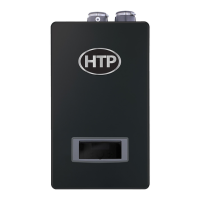87
LP-520 REV. 5.1.17
MAINTENANCE REPORT
In unusually dirty or dusty conditions, care must be taken to keep appliance cabinet door in place at all times. Failure to do so VOIDS
WARRANTY!
The appliance requires minimal periodic maintenance under normal conditions. However, in unusually dirty or dusty conditions, periodic
vacuuming of the cover to maintain visibility of the display and indicators is recommended.
Periodic maintenance should be performed once a year by a qualified service technician to assure that all the equipment is operating
safely and efficiently. The owner should make necessary arrangements with a qualified heating contractor for periodic maintenance of
the appliance. Installer must also inform the owner that the lack of proper care and maintenance of the appliance may result in a
hazardous condition.
Check appliance and system piping for any sign of leakage.
Leaking pipes could cause property damage. Make sure all
piping is properly supported.
Check condition of all vent pipes and joints. Ensure all vent
piping is properly supported. Check for obstructions exhaust
and intake termination points.
Check Gas piping, test for leaks and signs of aging. Make sure
all pipes are properly supported.
Do a full visual inspection of all system components.
Test all functions of the system (central heating, water heating,
safeties)
Verify safe settings on appliance or Anti-Scald Valve
Verify programmed temperature settings
Check wire connections. Make sure they are tight.
Verify devices are installed and working properly. Change
batteries if necessary.
Check to see that the circuit breaker is clearly labeled. Exercise
circuit breaker.
Verify ON/OFF switch and convenience plug are both functional
Check condensate neutralizer. Replace if necessary.
Disconnect condensate hose. Clean out dirt and re-install.
(NOTE: Verify the flow of condensate, making sure that the
hose is properly connected during final inspection.)
Measure incoming gas pressure (3.5” to 14” W.C.)
Measure drop in pressure on light off (no more than 1” W.C.)
Check piping for leaks. Verify that all are properly supported.
Check CO and CO2 levels in Exhaust. Record at high and low
fire.
Check continuity on Flue ECO. Replace if corroded.
It is recommended to flush the CH and DHW heat exchangers
annually if water hardness exceeds 12 grains per gallon
(considered extremely hard water). If water hardness falls below
12 grains per gallon it is recommended to flush the heat
exchanger every two to three years.
In addition, it is recommended to clean the CH and DHW inlet
filters annually.
Verify that you have completed entire check list. WARNING:
FAILURE TO DO SO COULD RESULT IN SERIOUS INJURY
OR DEATH.
Review what you have done with the homeowner.
Table 43 - *Continue annual maintenance beyond the 4
th
year as required.

